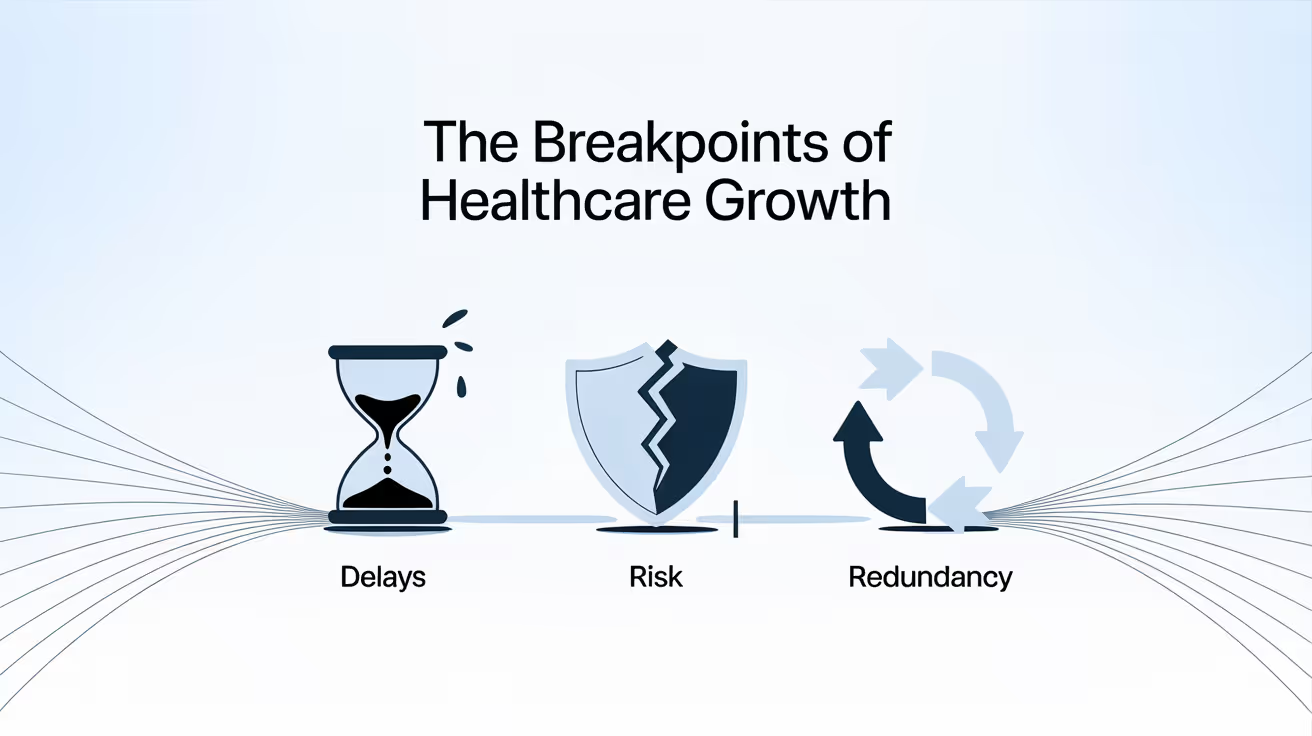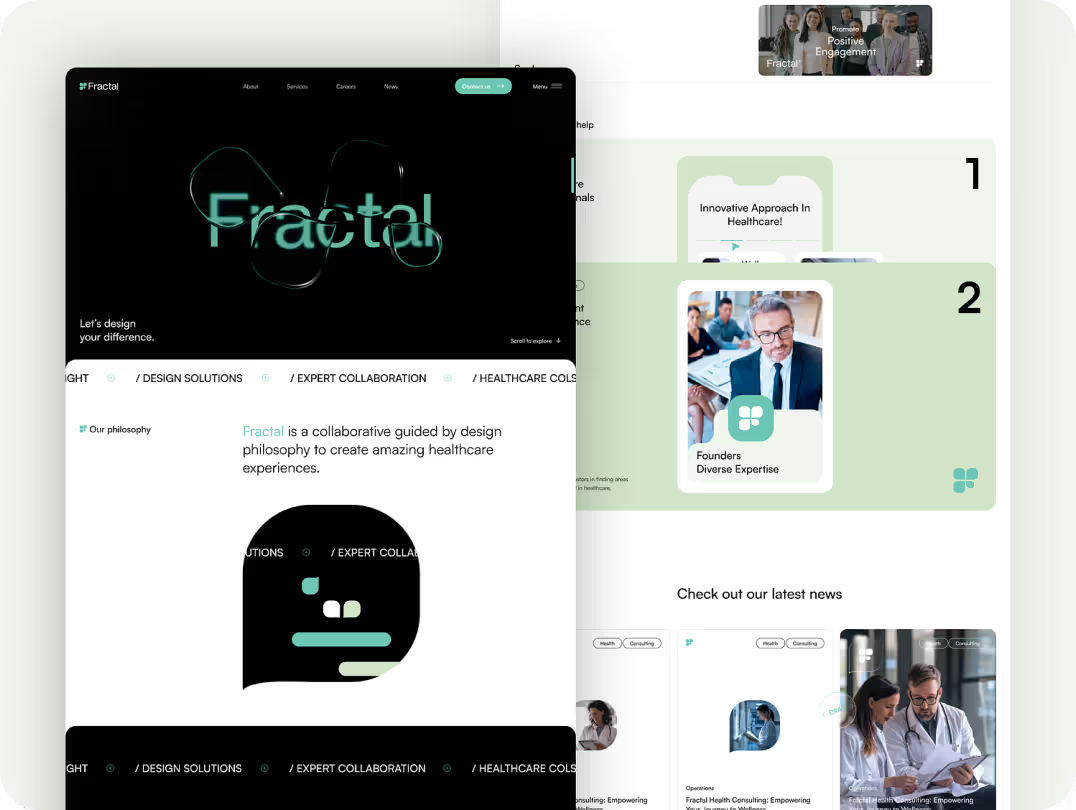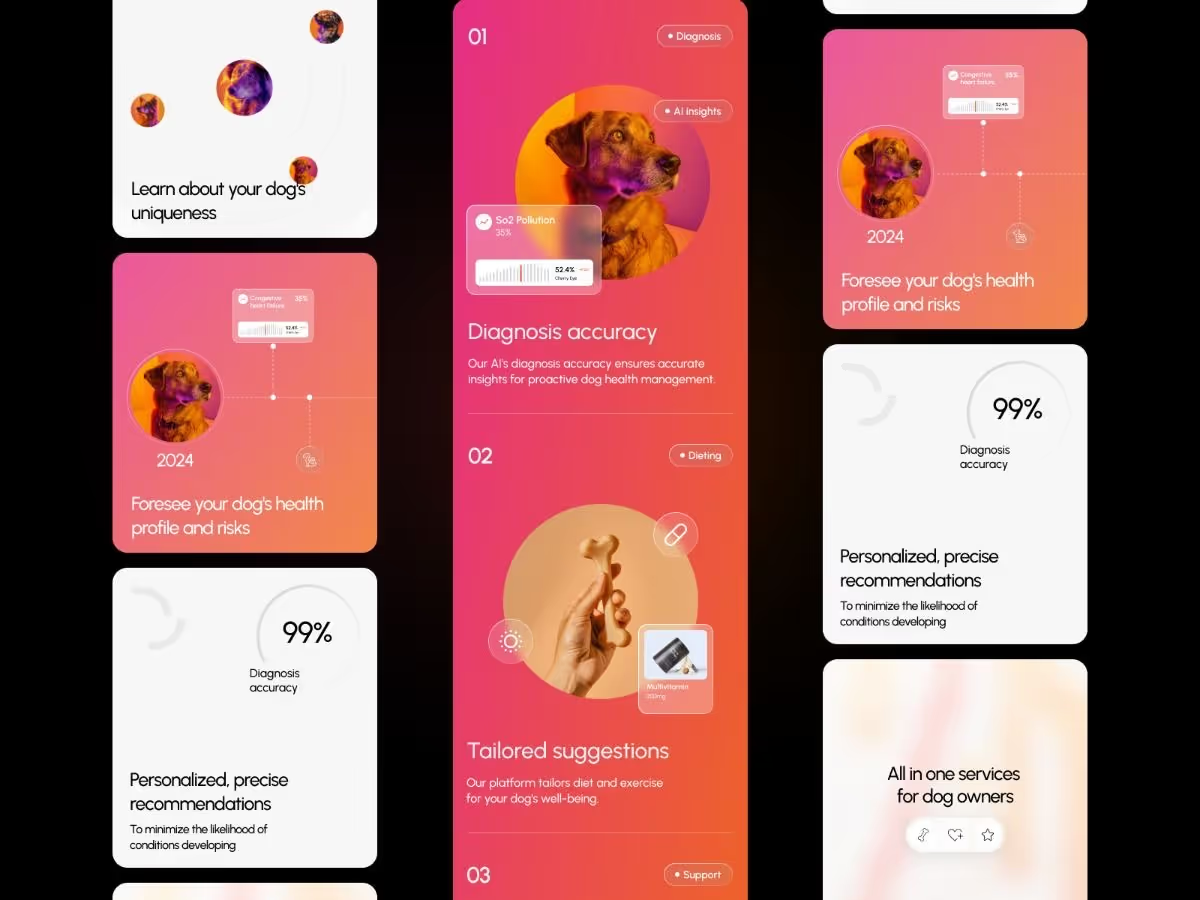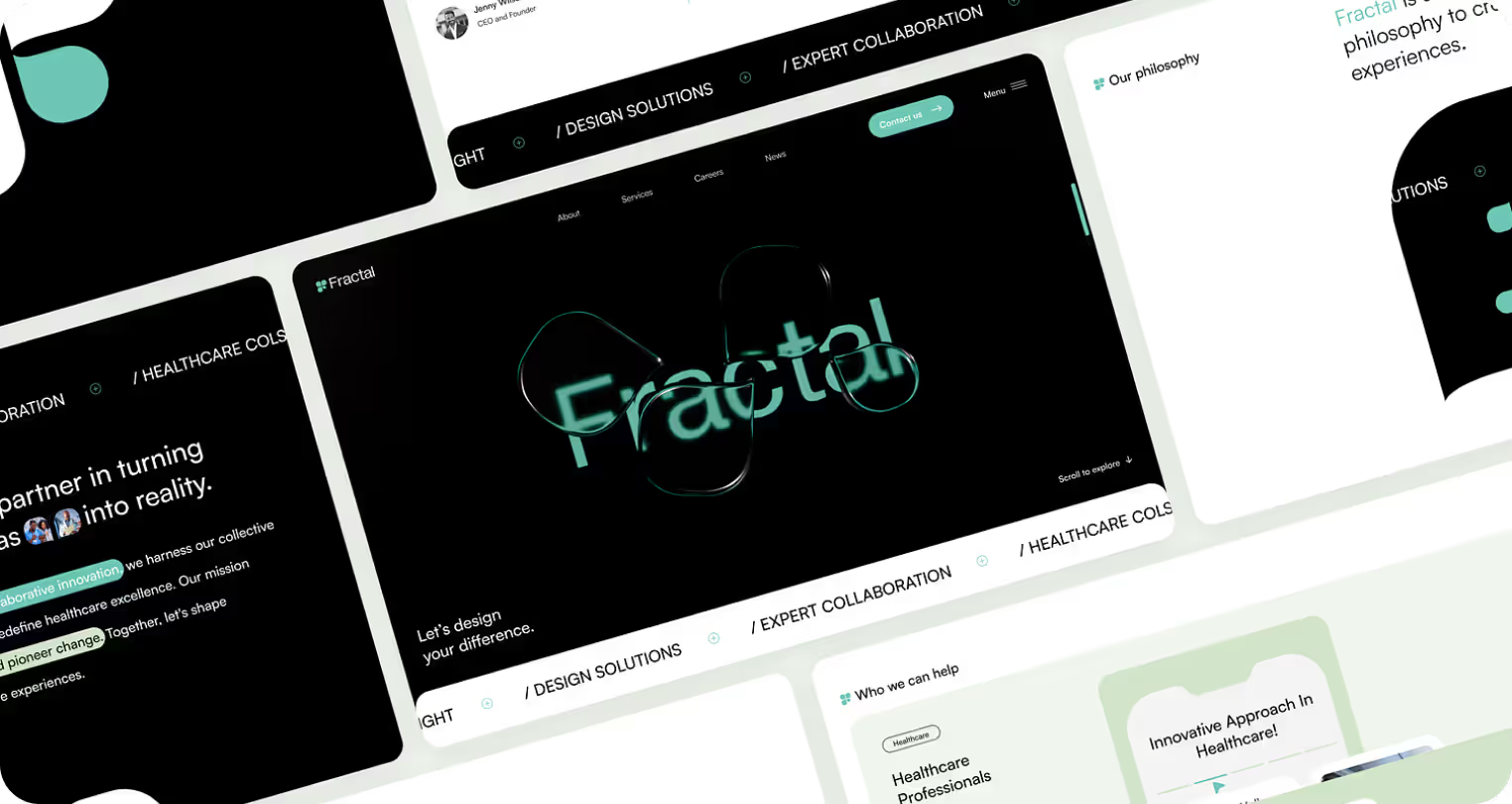Scalable Healthcare Website Development: Why Webflow Is the Smart Choice
%20(1).avif)
Close your eyes and imagine a digital waiting room: A homepage where patients scan services, insurance details, and testimonials – quietly evaluating whether this is the right place for their care.
They don’t leave feedback when something feels off. They just leave.
And with every exit, it’s not just traffic that disappears. It’s trust.
That’s why healthcare websites can’t afford to fall apart under pressure.
Yet that’s exactly what happens when they’re built on brittle platforms, slowed by dev bottlenecks, or patched together with outdated design systems. Traffic grows. Services expand. Content changes. But the backend stays fragile, and the frontend feels cold and clunky.
In healthcare, that’s more than a technical issue. It’s a credibility issue.
At Eloqwnt, we design healthcare websites that evolve with the demands of modern care – visually, functionally, and strategically. And after working across wellness, medtech, and clinical care, we’ve found one platform that consistently delivers the speed, flexibility, and structure growing brands demand: Webflow.
This isn’t just a CMS swap.
It’s about building a digital front door patients trust – and organizations can scale with.
Let’s show you how — and why it works.
Why Scalability Really Matters in Healthcare
Growth in healthcare rarely happens slowly.
*A clinic opens a second location.
*A startup expands telehealth services across three states.
*A wellness brand rolls out a new product line, backed by targeted campaigns and aggressive acquisition goals.
But while operations sprint forward, the website often stays stuck – held together by duct-taped templates, third-party plugins, and dev-dependent content models.
This disconnect isn’t just inconvenient – it creates invisible friction in how patients discover, navigate, and trust your brand online.
Because when your business scales, your website must scale with it:
- New locations need templated pages that update instantly
- Content changes should take minutes, not tickets
- Campaigns should launch on demand – not wait in line
And that’s where most systems fall short. They weren’t built to grow.
Which brings us to the first, and most common, breakdown…

Problem #1: Dev Cycles Kill Momentum
Healthcare teams move fast. Dev teams? Not so much.
Here’s what we see all the time:
- A new campaign is ready — but the landing page won’t be live for another two weeks.
- A provider bio needs editing — but it’s stuck behind a Jira ticket and a sprint cycle.
- A new location opens — but the site still shows “Coming Soon.”
It’s not that developers are slow. It’s that the system slows them down.
Traditional websites are built on frameworks that treat every update like a mini project. Even a copy tweak can snowball into a backlog item — needing QA, deployment, or worse, a cross-functional review. And while all of that churns behind the scenes, momentum stalls.
We worked with a healthcare client running a seasonal wellness campaign tied to insurance enrollment dates. Timing was everything — but every change required a two-week lead time. By the time updates went live, the window was half closed. The campaign underperformed, not because it was weak, but because the tech held it hostage.
The problem isn’t technical complexity. It’s workflow friction — and it compounds with every marketing initiative.
Problem #2: Compliance Can’t Be an Afterthought
In healthcare, design doesn’t just need to work. It needs to hold up under scrutiny.
Every page, form, and user interaction has to follow the rules — not just for legal reasons, but because the stakes are personal. You’re dealing with real people’s health, data, and trust. And that trust is fragile.
What does that look like in practice?
• HIPAA (Health Insurance Portability and Accountability Act): If your site collects or connects to personal health data, your entire stack — hosting, transmission, third-party tools — needs to be airtight.
• ADA (Americans with Disabilities Act): If your site isn’t accessible to users with visual, motor, or cognitive disabilities, you’re not only excluding patients — you’re opening yourself up to lawsuits.
• SSL, backups, permissions: The foundational stuff. Easily overlooked, especially when no clear processes are in place.
The challenge? With traditional site setups, these standards are easy to break without realizing it.
*A new image widget that isn’t accessible.
*A third-party app with questionable security.
*A permissions mix-up that gives the wrong team access.
Compliance issues don’t usually announce themselves. They hide — until they blow up.
Problem #3: Scaling Means Starting From Scratch
You shouldn’t have to rebuild every time you launch a new location or service. But that’s exactly what happens when sites are hardcoded or stitched together with brittle CMS structures.
For fast-moving healthcare brands, that kind of setup becomes a liability. Every expansion means duplicating layouts manually, chasing formatting issues, and reinventing workflows that should’ve been systematized from day one.
We’ve seen teams copy-paste entire service pages, adjust them by hand, then spend hours trying to make everything match. It’s inefficient, error-prone, and a nightmare to scale.
Worse, it creates inconsistency across the site — different pages look and behave differently, even when they’re supposed to be part of the same system.
As brands grow, so should their ability to move quickly and keep things cohesive. But without a smarter foundation, even basic updates can feel like pushing a boulder uphill.
Why Webflow Works for Healthcare Brands
Most platforms force a tradeoff:
- flexibility vs. control
- speed vs. design
- security vs. ease of use
Healthcare teams can’t afford those tradeoffs. When the stakes are high, the tech has to keep up — without slowing you down or locking you in.
That’s the kind of foundation this setup is built for.
Here’s how:
1. Instant Updates, No Dev Bottlenecks
Once the bottlenecks are gone, everything moves faster — and smarter. With Webflow, marketing and communications teams aren’t left waiting for tickets to be picked up or changes to be scheduled weeks out. They can move as fast as the campaign demands.
Need to launch a new service landing page? Build it visually and push it live the same day.
Want to A/B test a headline or switch out a hero image? No need to ping a dev — just update it in seconds.
Spotted a typo on a provider bio? Fix it before your next meeting ends.
It’s not just about having editing access. It’s about having confidence.
Your team gets a visual editor that’s intuitive to use, connected directly to your CMS, and safe enough that you don’t have to worry about breaking anything.
And that changes the entire dynamic:
*Marketing becomes more proactive.
*Content becomes more responsive.
*The website becomes a living, evolving tool — not a static asset collecting dust between dev cycles.
That kind of agility doesn’t just save time. It keeps the momentum going, so your digital presence always matches the pace of your growth.
2. A CMS Built to Scale
Growth shouldn’t mean chaos — and with the right CMS, it doesn’t have to.
Whether you’re managing five locations or scaling to fifty, the backend needs to be built for clarity, not clutter. Webflow makes that possible with custom CMS structures that mirror the real logic of your business: services, providers, clinics, regions, blog content — all neatly organized and ready to expand when you are.
Instead of hardcoding new pages or manually duplicating layouts, you simply add a new item to the CMS. The design stays consistent, the structure holds, and the update appears exactly where it should — no dev tickets, no formatting headaches.
We typically set up collections for:
• Core services, so every offering has its own polished, SEO-friendly page
• Provider bios, which automatically sync with the team directory and clinic pages
• Location content, tailored to specific regions, opening hours, insurance info, and team details
• Educational resources, including FAQs, symptom guides, or blog articles — so your content strategy doesn’t get buried in static page hell

This system is more than just scalable — it’s empowering. Your internal teams can make updates confidently, knowing the design integrity won’t break. And your brand experience stays clean and consistent, whether you’re managing a single-page update or rolling out a multi-location expansion.
It’s infrastructure that actually supports your momentum — instead of becoming another thing to wrestle with as you grow.
3. Design That Doesn’t Compromise Compliance
In healthcare, visual polish matters — but so does getting every technical detail right. With Webflow, there’s no need to choose between design excellence and compliance. It delivers both, seamlessly.
You get the flexibility to build a branded, memorable experience and the structure to meet ADA and WCAG standards out of the box. Everything works together — design, accessibility, and performance — without extra overhead or dev intervention.
Here’s how that plays out:
1. ADA accessibility is baked in: Webflow supports accessible HTML structure, ARIA labels, keyboard navigation, and color contrast controls natively. You’re not layering on accessibility — you’re designing with it from the start.
2. Fast performance is the baseline: Clean code, compressed assets, and responsive design ensure your site loads quickly across devices — something both patients and search engines will reward.
3. Visual consistency, everywhere: Pages are styled through global design systems, so every update stays in line with brand standards, and every layout adapts gracefully to screen sizes and device types.
4. SEO and structure handled automatically: Built-in tools help manage metadata, heading hierarchy, alt text, and more — essential for both compliance and visibility.
Rather than treating compliance as a checklist, Webflow makes it part of the design DNA. The end result is a site that doesn’t just meet expectations — it feels intuitive, inclusive, and trustworthy from the first click.
4. Built to Grow with You
Healthcare brands don’t sit still. One move leads to another — a clinic opening here, a new service rollout there, a campaign launch next quarter that needs to tie it all together. The last thing you need is a site that slows the momentum.
Webflow gives your team room to move — and keep moving.
- Growth doesn’t mean complexity: Whether you’re adding a single provider or scaling across multiple states, content scales cleanly through structured CMS fields and modular components. No clutter. No rebuilds.
- Every launch, one step ahead: Need to stand up a landing page for a campaign or a new region? Iteration is built in: Update messaging, test positioning, or localize content — all without touching a line of code. Because agility shouldn’t stop at the homepage.
The real power here isn’t just the tools — it’s the way they shift your workflow. Growth becomes less about managing the site, and more about unlocking new opportunities with it.
5. Security is Handled
Let’s tackle the elephant in the room: What about HIPAA?
Here’s the truth: Webflow is not a HIPAA-compliant platform for storing PHI – and that’s okay.
Here’s what we do:
1. Use Webflow as the front-end experience
2. Integrate with HIPAA-compliant platforms (for forms, portals, etc.)
3. Protect access with role-based permissions and SSL hosting
4. Embed accessibility and security into every design element

It’s not about hacking it. It’s about architecting the right solution for your needs – without compromising speed or design.
For most modern healthcare brands, this hybrid approach is exactly what they need.
Our Case Studies: What Success Looks Like with Webflow
At Eloqwnt, we don’t just build websites. We architect digital systems for healthcare brands that are ready to grow — and ready to leave outdated platforms (and problems) behind.
Here’s what that looks like in the wild:
Incipet
The challenge:
Incipet merges AI with modern pet care – and needed a site to match. It had to feel advanced yet warm, tell a human story, and handle rich animation without compromising performance.

Why Webflow worked:
Static pages wouldn’t cut it. We needed a platform that could:
- Power complex motion design and layered parallax without compromising speed
- Keep animations native and maintainable, without handing every update to a dev
- Make it easy to edit dynamic content like case studies, services, and provider bios in a clean CMS
Webflow handled all of it. No plugins. No patchwork. Just a smooth, scalable frontend with a powerful visual editor underneath.
The result:
- A site that feels alive, with animated storytelling and rich visual hierarchy
- Simplified CMS structure so the team can update content without worrying about breaking layouts
- A digital presence that finally lives up to the brand’s innovation
Fractal
The challenge:
Fractal isn’t just building one product – they’re accelerating dozens of healthcare ventures at once. They needed a site that could keep up with that pace, clarify their model, and evolve as fast as their ideas – all without losing the brand’s polish or credibility.

Why Webflow worked:
Webflow gave Fractal the flexibility to move fast without sacrificing clarity or control. It allowed us to:
- Build a modular design system that scales with new use cases and offerings
- Quickly prototype and refine messaging as each product evolves
- Keep content edits and investor updates in-house with a clean, structured CMS
And because Webflow doesn’t rely on plugins or templates, the experience stays light, fast, and unmistakably on-brand.
The result:
- A sleek, professional site that makes a complex healthcare model feel human and intuitive
- A future-ready platform that empowers rapid iteration and internal control
- A digital brand presence as forward-thinking as the services it supports
How Eloqwnt Builds for the Pace (and Pressure) of Modern Healthcare
Over time, we’ve honed a delivery model that’s made for the realities of modern healthcare brands — the speed, the compliance, the scale.
Here’s how we structure every build:
1. Strategic Mapping
Every project begins with clarity. We analyze the business model, identify bottlenecks, and define what needs to scale — all before a single pixel is placed. It’s a structured deep dive that ensures the website aligns with real-world growth goals, not just surface-level aesthetics.
2. Component-Based Design
Instead of static page designs, we craft flexible systems. Each element is modular and reusable, designed to work like a cohesive set — more like building with Lego than sketching in sand. This approach future-proofs the site, making expansion simple and efficient as needs evolve.
3. Compliance Built-In
Security, accessibility, and HIPAA-conscious workflows aren’t tacked on later — they’re embedded from the start. That means every touchpoint, form, and user interaction is built with healthcare standards in mind. It’s peace of mind, built into the blueprint.
4. Enablement & Training
Once the build is complete, control doesn’t stay with us. Teams are fully enabled with training, documentation, and structured CMS access tailored to real use. Updates become routine, not a request ticket — and digital independence becomes the norm, not the goal.
This approach builds long-term independence – and that’s the real ROI for most healthcare teams.
When Webflow Isn’t the Right Fit
Clarity matters — and so does choosing the right tool for the job. Webflow isn’t a universal solution, and we won’t pretend it is.
If your platform needs include:
- Deep backend complexity or proprietary systems
- Custom app logic or patient portals
- A fully HIPAA-compliant backend for storing PHI
…then another platform may serve you better.
But if you need a front-end that’s fast, flexible, and easy to manage — a system that makes your brand look as sharp as your care actually is — Webflow could be the foundation you’ve been missing.
Final Thoughts
Healthcare is personal. It’s urgent. It’s built on trust.
If your site isn’t reflecting that – if it’s holding back your growth, delaying your campaigns, or confusing your patients – then it’s time for a change.
Webflow gives you:
• Control without compromise
• Design freedom without compliance headaches
• Scalable structure without dev delays
And that’s what growing healthcare brands need now more than ever.
If you are one of them – let’s work together to bring your digital experience up to speed with your mission!











